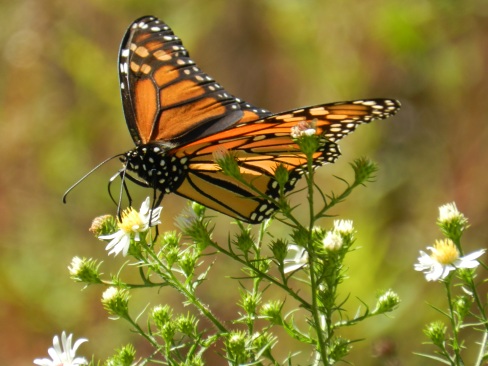
Native plants provide the best nectar sources for butterflies like this beautiful Monarch. In addition, many native insects can only reproduce on specific native plants.
I started this blog to celebrate our beautiful planet and the amazing diversity of life with which we share it, and hopefully, to inspire others to do the same. When we celebrate and appreciate the world around us, we want to take care of it. The effort we make, if only in our own backyard, makes a difference. Pretty soon, I will have a new backyard and with it, an incredible opportunity to create a haven for wildlife.
At the end of this year, my family will be moving to a 1.6 acre lot–a small patch of woods and open meadow along a creek. To make things even better, our property is adjacent to a large park with wooded trails and a lake. Although it is located in the same suburban neighborhood where we currently live, it feels a world away. I can’t wait to be settled in the home we are building, but more than that, I can’t wait to be settled in my own little nature sanctuary. So far, we’ve seen foxes and deer, numerous species of birds (including a resident Red-tailed Hawk), and scads of pollinating insects. One reason we have such an abundance and diversity of wildlife is the variety of native plants on the property.
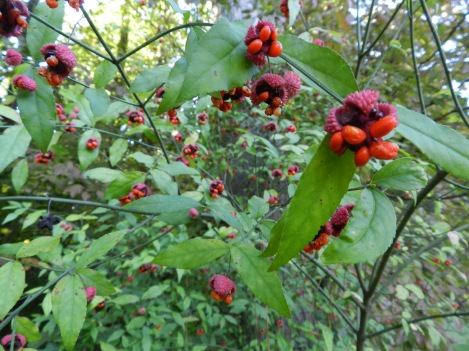
The leaves of Hearts-a-bursting are readily eaten by deer and rabbits, and the berries are consumed by birds.
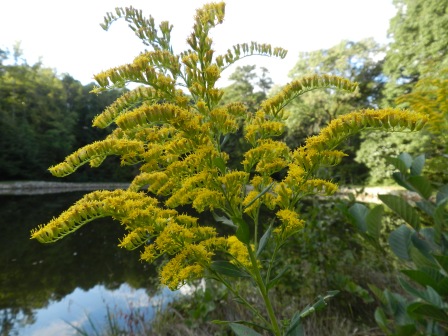
Goldenrod is a favorite of the American Goldfinch, and a number of other bird and mammal species dine on its seeds as well.
The lot we’ll soon call home has become overgrown with years of disuse, but in that disuse, it has become useful for the wildlife that shares the land with us. The meadow is covered with native grasses and wildflowers like heath aster, goldenrod, blue mistflower, and boneset, attracting many species of butterflies and birds. Splashes of jewelweed along the creek beckon the hummingbirds, and hearts-a-bursting bushes offer a bounty for woodland mammals and birds. The calls of nuthatches and chickadees resound from the tops of pines and oaks, and the dead tree that stands at the back of the property bears the marks of many woodpecker feasts. Aside from removing a few invasive exotic plants, I plan to leave the lot relatively untouched.
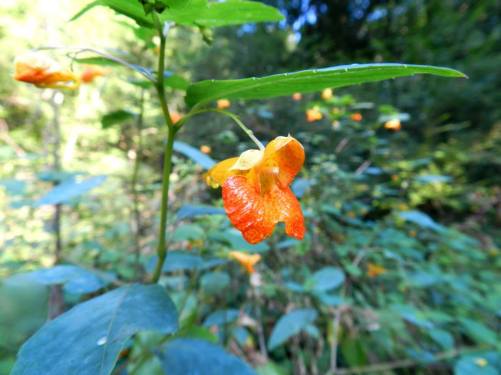
Jewelweed, which blooms in late summer and fall, helps migrating hummingbirds fatten up for their journey to Central America.
What we grow in our own backyards can profoundly affect the diversity of life around us. Non-native butterfly bushes, for example, are touted as excellent nectar plants, but cannot support the reproduction of a single species of butterfly in North America. Native plants are much better at sustaining biodiversity, which is crucial to the health of our planet and our very existence. In contrast, the typical American yard, comprised of tidy, mowed grass and non-native flowering plants and shrubs, provides very little benefit to wildlife and actually does harm to the environment. Here are a few facts about lawns that may surprise you:
- Lawn grasses are not native to the North American continent and make poor habitat for wildlife.
- Lawn grasses and exotic (non-native) plants reduce or eliminate insects available for insectivorous birds, as well as for other birds when they are feeding nestlings.
- Acre for acre, the American lawn receives four times as much chemical pesticide as any U.S. farmland, killing an estimated seven million birds each year.
- Phosphorus runoff from lawn fertilizer causes algae blooms that suck oxygen out of our waterways, killing aquatic life.
- During summer months, as much as 60% of municipal water usage goes to lawns. (In a time when much of our nation is facing catastrophic drought, water is a resource we should be using wisely.)
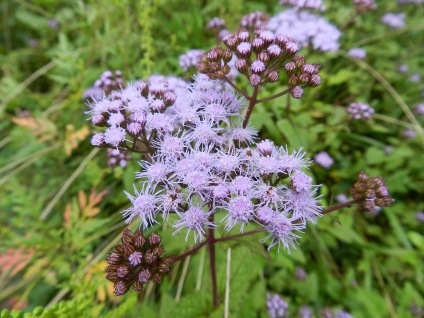
Blue Mistflower produces dense flower clusters and covers the ground with a matt of leaves. I’ll take this over a traditional lawn any day!
Plants and animals share a profound connection. Plants provide food and clean air to breath, as well as sustain wildlife. Wildlife, in turn, offers a number of tangible and invaluable services to people–such as pollination, seed dispersal, pest control, and sanitation. We can’t afford to be careless about protecting our earth and the life we share it with. We are currently living during the “sixth mass extinction,” the greatest extinction period since dinosaurs were wiped off the planet, so we can’t act too soon.
So, start with your own backyard–it needn’t be large to make a difference! Add some beautiful native plants to your landscape that will attract more butterflies, birds, and other wildlife. Learn more about backyard wildlife sanctuary certification programs in your area, and have your yard certified as an example for others. You’ll be doing yourself and the earth a favor. In the wise words of anthropologist Margaret Mead, “Never doubt that a small group of thoughtful, committed citizens can change the world; indeed, it is the only thing that ever has.” _____________________________________________________________________
An incredible and beautiful book about the connections between native plants and healthy ecosystems is Doug Tallamy’s Bringing Nature Home.
Many states have native plant societies which can help you learn more about the best plants to grow in your area. To learn about native plants in Georgia, including the best places to buy them, check out the Georgia Native Plant Society.
A wonderful blog about gardening with native plants is The Humane Gardener.

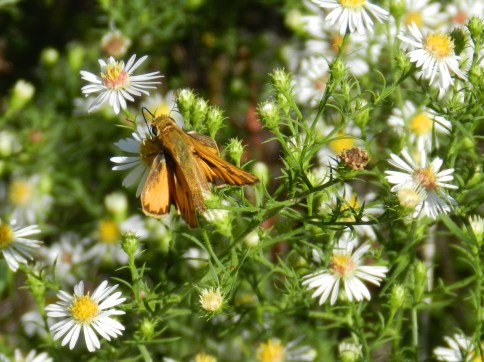
These are great resources and links. I’d like to add that native plants unlike exotics offer food for many caterpillars and other larvae. This is how native plants are crucial to the reproduction of native insects.
Absolutely! I thought that was implied in my statement that exotics reduce the numbers of insects, and the specific mention that butterfly bushes don’t support the reproduction of a single species of butterfly. Thanks for clearly stating the connection. 🙂
Here’s another great discussion of the issue. The article explains when we give local insects “plants that evolved on another continent, chances are those insects will be unable to eat them. We used to think this was good. Kill all insects before they eat our plants! But a plant that cannot pass on the energy it has harnessed cannot fulfill its role in the food web.”
This author’s research “has shown that alien ornamentals support 29 times fewer animals than do native ornamentals.”
https://www.americanforests.org/magazine/article/backyard-biodiversity/
Absolutely!
What beautiful pictures! I would love to rid ourselves of grass … it is way too much upkeep … what do you suggest in place of grass in areas where the dog roams?!
Hi Jayleen! Thanks for reading. I’m not sure where you live but I would recommend doing a web search for “Eco-lawn” or “ecology lawn” for your area, which should yield resources for a number of low-growing perennial plants that will grow in your region. There should be lots of low-maintenance, easy to grow, and attractive options. Here’s a link to a bit of info about the Eco-lawn: http://seattletimes.com/html/homegarden/2003910283_philgarden29.html.
My current backyard contains a bit of the grass my husband has tried to grow over the years, but primarily consists of clover, which is actually lovely and has the added benefit of providing a great food source for me to bring in for the orphaned bunnies that we get in at the wildlife rehab center where I volunteer. 🙂
Good luck, and keep me posted!
Thank you for the resource! I’ll check it out! We have plenty of clover but no bunnies to feed it too;0) Perhaps we should just leave it and not worry about making the grass so grassy;0)
Clover (and dandelions, too) don’t get a fair shake. When we adjust our perspective a bit, we can see them for the lovely plants they are. They’re certainly a hit with the critters!
Hi Melanie, thanks again for the shout-out! I’m amazed by how similar your plant life is. How cool that you are inheriting a property where you simply have to subtract invasives rather than add natives. I have a terrible story about jewelweed. Years ago it was growing along the fenceline, and I thought it was so beautiful. But for some inexplicable reason I also thought it was invasive. (Looking back, knowing what I know now, it was probably a combination of my ignorance and the fact that a lot of agricultural sites still declare many natives as noxious and “menaces” and the like.) So we pulled it all out, much to my chagrin when I discovered later that it’s native.
Also, are these hearts-a-burstin’ on your new property? They are so, so pretty. I have planted two, but they keep getting munched on, so they are still sticks. Still alive, but still sticks. I think it’s time for some tree wrappers or something so they can get to a good size before getting nibbled. 🙂
Thanks, Nancy! I have so much to learn about gardening/plants, but I’ve learned a lot in a short time. I feel like I’ve been given new eyes in this decade of my life! It was your blog that taught me about boneset!
Oops-reply sent accidentally before I was finished. The hearts-a-burstin’ are on our new property. I just love them! One is the size of a small tree! I feel lucky to be inheriting these treasures. Where do you live? Not in the south, I gather. Look forward to reading your future posts!
Pingback: Suburban Safari* | My Eco-centric Life
I get pleasure from, cause I discovered exactly what I was looking for. You’ve ended my four day lengthy hunt! God Bless you man. Have a nice day. Bye